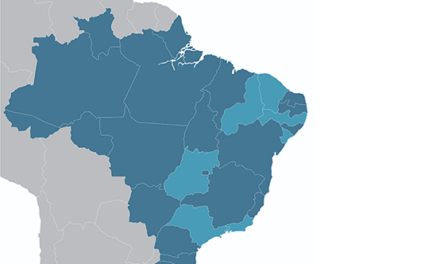
The capacity to make sense of another person’s thoughts and feelings underlies a host of social-emotional learning outcomes.
To skeptical teachers and school administrators, social-emotional learning (SEL) might appear to be just another educational fad, the latest in a long line of reforms that fail to live up to their hype. But in fact, the SEL movement’s fate is not preordained.
When we drill down to the core of what makes us social animals, we find a specific human capacity — the ability to discern other people’s thoughts and feelings — that is entirely teachable. Unlike a host of other reform movements that have come and gone, SEL shows real staying power.
To understand what makes SEL so promising, compare it to another recent reform movement, which now appears to be waning: the effort to evaluate teacher effectiveness based on test scores.
Why educational fads go bad
For about a dozen years, policymakers have enthused over the notion that clever analysis of data from student achievement tests might allow them to identify effective teachers. At first, their enthusiasm seemed justified. After all, teaching has an outsized effect on children’s learning, and — unlike factors such as poverty (Berliner, 2013) — it is something that school leaders might actually be able to influence. If leaders could distinguish the best teachers from the underperformers, then perhaps they could use that information to improve teaching and make real headway on improving outcomes for the neediest students.
However, while “effective teaching” may sound like a single thing, which administrators can measure and promote, the term actually represents a complex confluence of factors (Koedinger, Booth, & Klahr, 2013). Many different teaching approaches can be effective (lecturing, assigning group work, personalizing instruction, blending in-person and online work, flipping the classroom, and so on), and any given approach might be particularly effective or ineffective for any particular group of students. Further, other factors can influence teachers’ effectiveness, from the size and composition of the class to the content to be taught and the effectiveness of the previous teacher, not to mention whether students ate breakfast that morning, or whether Irene really dumped Sam for his best friend. To complicate matters even more, we desire many different outcomes for students. We don’t merely want them to learn content. We also want them to engage with the material, to become college- and career-ready, to learn critical thinking and kindness, to find inspiration to pursue a greater purpose, and even to become healthy eaters.
Multiply many teaching approaches by many classroom factors by many learning needs by many desired outcomes, and “effective teaching” turns out to have hundreds, if not thousands, of permutations. Thus, nobody should be surprised by the disappointing results emerging from recent efforts to identify effective teachers based solely on test-score gains (Baker et al., 2010).
Why SEL is different
Right now, the concept of social-emotional learning is generating tremendous energy and enthusiasm among many school leaders, much as test-based teacher evaluation did just a few years ago. Once again, the early enthusiasm seems justified. Socially savvy students who manage their emotions adeptly tend to collaborate better with peers (Johnson, 1975), relate better to their teachers (Gehlbach, Brinkworth, & Harris, 2012), and get better grades (Wentzel, 1991). Students who learn these things will be well-prepared for adult life; companies like Google will want to hire these graduates (Bock, 2015).
However, as with the issue of effective teaching, we quickly wade into messy terrain. First, which social-emotional skills matter most? We want students to be caring, morally upstanding, purpose-driven, empathetic, and on and on. So how do we prioritize? Second, which of these proficiencies can educators realistically affect? Schools might change student mind-sets to convince them that their intelligence can grow (Paunesku et al., 2015), but can they realistically make children become more caring? Besides, aren’t some of these values more the purview of the home than the school?
In short, we may be tempted to assume that the SEL movement’s trajectory will mirror the effort to promote teacher effectiveness: We will get excited about it, implement a handful of versions, find ourselves daunted by the vast array of components that need to be taught and assessed, become frustrated, and then move on to the next big thing. But this need not be the case. Like the concept of teacher effectiveness, SEL is a deceptively simple label attached to an enormously complex range of issues. SEL encompasses all sorts of specific and hard-to-define skills, dispositions, and attitudes that we want children to acquire. However, at the core of SEL — after one peels away the surrounding layers — lies a single, teachable capacity that anchors almost all of our social interactions: social perspective taking, or the capacity to make sense of others’ thoughts and feelings.
The motivation and ability to “read” other people, vividly imagining their unique psychological experience, provides the compass by which we navigate our social world. This capacity allows us to interpret the motivations and behaviors of our friends and neighbors, or to see situations from the point of view of strangers, or to understand and appreciate values and beliefs that diverge from our own. Without it, we cannot empathize, engage in moral reasoning, love, or even hold a normal conversation.
Research findings indicate that when people become more capable at perspective taking, they become less likely to stereotype others (Galinsky & Moskowitz, 2000), they respond less aggressively when provoked (Richardson, Green, & Lago, 1998), and they develop more positive relationships with those who hold beliefs that differ from their own (Gehlbach et al., 2015). These and many other findings suggest that improving this one core capacity can generate ripple effects across many of the other aspects of social-emotional learning that we care about.
The most crucial step toward developing a stronger capacity for social perspective taking is to muster the motivation to engage in it with people we don’t already care about.
Moreover, recent scholarship suggests that this capacity can be learned and strengthened in school. As I’ve found in my own research, the development of social perspective taking can be described as a process, requiring four key steps: First, we must become motivated to take the perspective of some person of interest (Gehlbach, Brinkworth, & Wang, 2012). Because our complex social worlds constantly bombard us with information, focusing on and making sense of other people’s thoughts and feelings can take real effort. When it comes to our spouses, bosses, close friends, and children, we tend to put forth this effort, but we might not be so motivated to read and understand the perspective of the cashier, the driver who cuts us off on the freeway, or the high school nemesis we encounter at the reunion. Perhaps the most crucial step toward developing a stronger capacity for social perspective taking, then, is to muster the motivation to engage in it with people we don’t already care about.
Second, once we generate sufficient motivation to “read” other people, we must select a particular strategy to enact (Gehlbach, Brinkworth, & Wang, 2012). A whole menu of such strategies exists, and some of them are common enough to have acquired their own aphorisms — “putting yourself in someone else’s shoes,” for example. But other strategies are less obvious. For example, suppose I enjoy public speaking, while you see it as cruel and unusual punishment. If you’re anxious about, say, giving a wedding toast, I could try to put myself in your shoes. Yet, that won’t help me understand what you’re going through; after all, when I imagine delivering the toast, I feel pretty calm. If I want to get a more vivid sense of your emotional experience, a better strategy would be to think of an analogous situation, such as by recalling the panic I felt while sitting at the dentist’s office awaiting news about a possible root canal. The memory has nothing to do with making a speech, but it should help me better sense what you’re feeling.
Third, we must coordinate the available data sources with our chosen strategy to make inferences about the other party. If you’re talking with someone on the phone, for example, there’s no point in trying to read their body language. You cannot access that data. But if you’re meeting in person, this strategy becomes more viable; you certainly can draw inferences from gestures and facial expressions. If Jack normally has a sunny disposition but now he’s all frowns and furrowed brows, you can presume that something has gone wrong. In short, so long as our strategies for reading people match the data sources at hand, we can often make pretty accurate inferences about other people’s feelings, beliefs, and motivations.
Fourth, after we make inferences, we must evaluate whether we are on the right track. In some cases, our very first attempt to make sense of another’s perspective rewards us with a clear sense of what they’re thinking. Other times, we might begin to understand what makes that person tick, but we continue to have questions. Or we might realize that we’ve made a mistake — completely misreading their feelings or intent — and need to start over. One of the vexing challenges, here, is that we rarely get explicit feedback letting us know how accurately we’re reading others. We might see Jacob walking across the street, and we’ll judge that he seems happier than usual today; when Aaron suggests an idea in class and Sarah smirks in response, we’ll assume that she dislikes his input; as Byron and Sejin give each other sideways glances, we’ll assume that they disagree. Most of the time, though, we are unable to find out for sure whether these inferences are on target. All we can do is to keep seeking feedback, keep trying to read people, and keep refining our impressions as we learn more.
The ability to “read” other people, vividly imagining their unique psychological experience, is the compass by which we navigate our social world.
As I noted above, recent research findings suggest that if students improve their social perspective taking, their other social-emotional skills should improve correspondingly. Related research shows that social perspective taking can be learned in school: If students become sufficiently motivated to strengthen this skill (Klein & Hodges, 2001), if they select effective strategies (Lord, Lepper, & Preston, 1984), if they wisely adapt those strategies to fit the given situations (Ames, 2004), and if they continue to seek feedback and revise their impressions (Marangoni et al., 1995), then they tend to improve their ability to make sense of others’ thoughts and feelings.
Teaching social perspective taking: Three priorities
Given that perspective taking underlies so many valued social-emotional learning skills, educators will wonder how to cultivate it in students. The good news is that doing so can be integrated into any class, at any grade level, through a variety of approaches.
The three key strategies offered below can easily be incorporated into any teacher’s repertoire:
#1. Make it your habit to ask for multiple perspectives. Through the repetition of everyday routines — from requiring students to raise their hands when they want to talk to ringing a bell to mark the end of a class period — most schools are quite good at inventing and instilling strong social norms. There’s no reason why schools can’t establish a norm that students regularly read and explore others’ perspectives during classroom discussions.
For teachers, this requires nothing more complicated than asking multiple students to give different responses to complex questions (e.g., “What are some possible reasons why the British may have wanted to appease Hitler?”) rather than posing questions that invite a single “right answer” (e.g., “Why did the British appease Hitler?”).
Teachers can also ask students to play devil’s advocate or to restate each other’s points before responding to them. When disagreements or interpersonal conflicts arise, it should be considered the norm for students to explain their side of the story and to listen while the other side explains theirs.
#2. Encourage students to be social detectives, not judges. In addition to defining social perspective taking as the new normal in classroom discussions and activities, schools can teach students to see themselves as social detectives rather than judges of social behavior. Admittedly, it’s often easier to make judgments (e.g., to declare that the teacher handed out low grades because she’s mean, or that a kid started a rumor because he’s spiteful) than to withhold them. But while it may be easy and satisfying to jump to such conclusions, doing so is rarely productive. By contrast, we can teach students to hold off on judging others and instead investigate the reasons for another person’s behavior, asking, “Why might she have done that?” or “What’s his version of what happened?” Such questions can be especially useful tools in the classroom. The more that students get in the habit of investigating others’ perspectives rather than rushing to judge them, the more skilled they’ll become at looking for clues that might illuminate others’ decisions and behaviors. In short, detectives are likely to make more accurate, less biased inferences about others’ motives and beliefs.
#3. Provide opportunities for feedback as students learn to read others’ perspectives. We should ensure that students have many low-stakes opportunities to practice social perspective taking. It is critically important to put young people in situations where it’s OK to make mistakes and receive feedback that might otherwise be elusive. For instance, before the start of a classroom debate, a teacher can ask students to jot down predictions as to which peers will make which arguments. This makes the social perspective taking process explicit. As the debate unfolds, students can see how accurately or inaccurately they predicted their classmates’ beliefs. Over time, this should help students think more critically about how they read others and the kinds of information they rely on in their perspective-taking attempts.
Schools can teach students to see themselves as social detectives rather than judges of social behavior.
If students engage in the social perspective-taking process regularly, adopting the mind-set of a detective rather than a judge, and if they receive frequent feedback, their skills at reading others will blossom. As they strengthen this fundamental capacity, a host of other desired social-emotional learning skills will likely unfold as well. Once in the habit of trying to gauge other people’s ways of looking at the world, they will inevitably become more empathetic, more understanding, and more caring; they will become more thoughtful about how to navigate relationships; and they will become more likely to reach out across cultural groups rather than withdrawing into their own clique.
Educators who are serious about teaching social-emotional learning skills will profit from these recent scholarly insights into social perspective taking. This doesn’t mean that they should ignore the research on teacher effectiveness and other factors that contribute to student success. But if they do seek out and try to learn from the most effective teachers, one of the first things they will notice is just how adroitly those teachers take the perspective of their students (Riley, 2009).
References
Ames, D. (2004). Inside the mind-reader’s toolkit: Projection and stereotyping in mental state inference. Journal of Personality and Social Psychology, 87 (3), 340-353.
Baker, E.L., Barton, P.E., Darling-Hammond, L., Haertel, E., Ladd, H.F., Linn, R.L., Ravitch, D., Rothstein, R., Shavelson, R., & Shepard, L.A. (2010). Problems with the use of student test scores to evaluate teachers. EPI Briefing Paper #278. www.epi.org/publication/bp278.
Berliner, D.C. (2013). Effects of inequality and poverty vs. teachers and schooling on America’s youth. Teachers College Record, 115 (12).
Bock, L. (2015). Work rules!: Insights from inside Google that will transform how you live and lead. New York, NY: Twelve.
Galinsky, A.D. & Moskowitz, G.B. (2000). Perspective taking: Decreasing stereotype expression, stereotype accessibility, and in-group favoritism. Journal of Personality and Social Psychology, 78(4), 708-724.
Gehlbach, H., Brinkworth, M.E., & Harris, A.D. (2012). Changes in teacher-student relationships. British Journal of Educational Psychology, 82, 690-704.
Gehlbach, H., Brinkworth, M.E., & Wang, M.-T. (2012). The social perspective-taking process: What motivates individuals to take another’s perspective? Teachers College Record, 114 (1), 197-225.
Gehlbach, H., Marietta, G., King, A., Karutz, C., Bailenson, J.N., & Dede, C. (2015). Many ways to walk a mile in another’s moccasins: Type of social perspective taking and its effect on negotiation outcomes. Computers in Human Behavior, 52, 523-532.
Johnson, D.W. (1975). Cooperativeness and social perspective taking. Journal of Personality and Social Psychology, 31, 241-244.
Klein, K.J.K. & Hodges, S.D. (2001). Gender differences, motivation, and empathic accuracy: When it pays to understand. Personality and Social Psychology Bulletin, 27 (6), 720-730.
Koedinger, K.R., Booth, J.L., & Klahr, D. (2013). Instructional complexity and the science to constrain it. Science, 342 (6161), 935-937.
Lord, C.G., Lepper, M.R., & Preston, E. (1984). Considering the opposite: A corrective strategy for social judgment. Journal of Personality and Social Psychology, 47 (6), 1231-1243.
Marangoni, C., Garcia, S., Ickes, W., & Teng, G. (1995). Empathic accuracy in a clinically relevant setting. Journal of Personality and Social Psychology, 68 (5), 854-869.
Paunesku, D., Walton, G.M., Romero, C., Smith, E.N., Yeager, D.S., & Dweck, C.S. (2015). Mind-set interventions are a scalable treatment for academic underachievement. Psychological Science, 26 (6), 784-793.
Richardson, D.R., Green, L.R., & Lago, T. (1998). The relationship between perspective taking and nonaggressive responding in the face of an attack. Journal of Personality, 66 (2), 235-256.
Riley, N.S. (2009, November 13). America’s top college professor. The Wall Street Journal. http://bit.ly/topprof
Wentzel, K.R. (1991). Relations between social competence and academic achievement in early adolescence. Child Development, 62 (5), 1066-1078.
This article originally appeared in the March 2017 issue of Kappan, Vol. 98, No. 6.
ABOUT THE AUTHOR

Hunter Gehlbach
HUNTER GEHLBACH is an associate professor at the Gevirtz Graduate School of Education, University of California, Santa Barbara, and director of research at Panorama Education.










